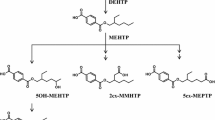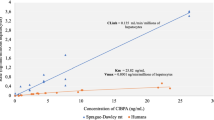Abstract
Chronic bioassays with trichloroethene (TRI) demonstrated carcinogenicity in mice (hepatocellular carcinomas) and rats (renal tubular cell adenomas and carcinomas). The chronic toxicity and carcinogenicity is due to bioactivation reactions. TRI is metabolized by cytochrome P450 and by conjugation with glutathione. Glutathione conjugation results in S-(dichlorovinyl) glutathione (DCVG) and is presumed to be the initial biotransformation step resulting in the formation of nephrotoxic metabolites. Enzymes of the mercapturic acid pathway cleave DCVG to the corresponding cysteine S-conjugate, which is, after translocation to the kidney, cleaved by renal cysteine S-conjugate β-lyase to the electrophile chlorothioketene. After N-acetylation, cysteine S-conjugates are also excreted as mercapturic acids in urine. The object of this study was the dose-dependent quantification of the two isomers of N-acetyl-S-(dichlorovinyl)-L-cysteine, trichloroethanol and trichloroacetic acid, as markers for the glutathione- and cytochrome P450-mediated metabolism, respectively, in the urine of humans and rats after exposure to TRI. Three male volunteers and four rats were exposed to 40, 80 and 160 ppm TRI for 6 h. A dose-dependent increase in the excretion of trichloroacetic acid, trichloroethanol and N-acetyl-S-(dichlorovinyl)-L-cysteine after exposure to TRI was found both in humans and rats. Amounts of 3100 μmol trichloroacetic acid+trichloroethanol and 0.45 μmol mercapturic acids were excreted in urine of humans over 48 h after exposure to 160 ppm TRI. The ratio of trichloroacetic acid+trichloroethanol/mercapturic acid excretion was comparable in rats and humans. A slow rate of elimination with urine of N-acetyl-S-(dichlorovinyl)-L-cysteine was observed both in humans and in rats. However, the ratio of the two isomers of N-acetyl-S-(dichlorovinyl)-L-cysteine was different in man and rat. The results confirm the finding of the urinary excretion of mercapturic acids in humans after TRI exposure and suggest the formation of reactive intermediates in the metabolism of TRI after bioactivation by glutathione also in humans.
Similar content being viewed by others
Author information
Authors and Affiliations
Additional information
Received: 22 June 1995 / Accepted: 5 October 1995
Rights and permissions
About this article
Cite this article
Bernauer, U., Birner, G., Dekant, W. et al. Biotransformation of trichloroethene: dose-dependent excretion of 2,2,2-trichloro-metabolites and mercapturic acids in rats and humans after inhalation. Arch Toxicol 70, 338–346 (1996). https://doi.org/10.1007/s002040050283
Issue Date:
DOI: https://doi.org/10.1007/s002040050283




